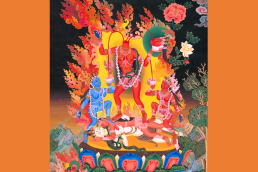Desire is critically important for living a good life, both at a basic level and in society. Desire fuels the achievement of the highest goals of human fulfillment.
I’m not just talking about sexual desire here, but any volition, motivation, direction, wish, etc. The “movement towards” any impulse.
The number of ancient sacred texts that extensively (and generally negatively) discuss desire is surprising. “Suffering comes from desire,” “humans are slaves to their impulses,” and so on. Everything points to a need to elude desire. Asceticism rejects desire altogether. So perhaps reinventing desire’s endgame is worth consideration.
What permits use to reach the transcendent heights described in these texts is powerful spiritual aspiration. In other words desire. Not just any desire, of course.
Extinguishing desire?
In “developed” societies, we do everything to extinguish desire by satisfying it as quickly as possible. Desire is uncomfortable. Most of us immediately grab for the object of desire to free ourselves from this tension. Our motto seems to be: “Long live satiety: the state where desire is dead”.
An author once wrote that the goal of any desire is its own extinction. It’s a very rich idea, and it is the direction that humans generally follow. Satiety, however, flattens “the vital impulse towards.”
Rethinking desire
Think how beautiful desire’s tension towards life can be. If we’re paying attention, we see the beauty of cultivating this tension when we are deeply in love. Have you ever experienced it? If so, you know that the moments when we feel intensely in love are those moments when we have a thirst for the other person.
If the other person overwhelms us with attention to the point where we feel satiated, we no longer experience this thirst. Sated, we suddenly no longer feel that irresistible tension towards the other person. We might conclude that, sadly, we are no longer “in love”.
Yet when we are in that heightened state we love the tension. We love “being in love”.
Let’s acknowledge that this state entails a degree of hunger and tension. A sort of ache that is unresolved. The tension can feel strong and beautiful as long as we prevent satiety from settling in. But too often our biology rushes us to crush relationship tension with a tsunami of passion.
My point here was only to give an example that highlights that the tension of desire can produce some discomfort. Yet our discomfort exists chiefly in relation to our perceptions and societal concepts of comfort. We have forgotten a great lesson: Growth happens outside the comfort zone.
Comfort seeking
Have you ever noticed that in almost all societies the goal is always to have more and more comfort?
And I’m not just talking about developed countries.
Why travel 10 kilometers to fetch water when you can have clean water from a tap at home?
In a society where we aim to eliminate all discomfort we also risk killing real inner growth. Is reinventing desire’s endgame so hard?
Resisting the lure of satiation
I propose we keep desire alive using an approach of moderation. A path that humans have rarely traveled. The path of those who learn to love beneficial tension in life.
Let’s cultivate the beauty of the strength of this impulse, nurture it, help it thrive, and circulate its power within ourselves. Let’s not hurry to extinguish it as humans have generally done through either asceticism or indulgence (exhaustion).
Many of the tantric, Taoist, Western esoteric, and hormesis practices are linked to this middle path of tapping the impulse of desire, while neither unduly inflaming it nor extinguishing it.
If we delve deeper into the study of advanced yogic-tantric practices, we realise that non-orgasmic sacred sexuality practices make complete sense when we fully grasp these ideas of preserving desire and learning to circulate it.
Inverting the flow of the life impulse
Pranayama and Urdhvareta (two very important notions of Yoga and Dharmic practices) call for the reversal of prana and the natural impulse. We circulate our vitality inward and upward (not outward).
The entire philosophy of the Natha (or Nath) Yogis called Ulta Sadhana (the practice of the great inversion) rests on the same concept. Kundalini (the force that can bring about liberation) is all about an inversion of the flow of the life impulse. Kundalini is Shakti. Shakti is the force of desire within the universe: the primordial impulse and its creative force!
When we preserve desire within ourselves we preserve Shakti and reverse the tendency to stifle it. Unfortunately, the unhelpful tendency toward extinguishing desire is advised in almost all religious and societal trends.
So, yes, initially, an inversion of the usual desire tendencies could help us learn to eat better, live better, have better relationships, etc. Yet desire also fuels some of the advanced concepts of transformation found in ancient Tantras, Yogas, Taoism, and various Western esoteric traditions! Thus desire is quite important.
Desire: the flame of ascension
Instead of seeing desire as something to satisfy or repress, let’s see it as a force to ride upon in order to ascend to the most beautiful realms of existence. So reinventing desire’s endgame is the way to go.
The fire of desire that burns you, if it arises from love, can transform your life into paradise.



